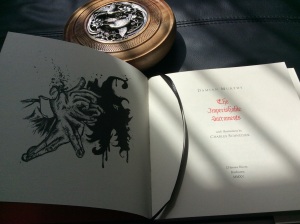The Imperishable Sacraments

A real-time review by Des Lewis.
I have just received this book as purchased from the publisher…
 THE IMPERISHABLE SACRAMENTS by Damian Murphy
THE IMPERISHABLE SACRAMENTS by Damian MurphyIllustrations (some pull-out) by Charles Schneider
Published by L’Homme Récent
Bucharest MMXV
My previous reviews of work by this author HERE.
My previous reviews of this publisher’s many books HERE
I intend to real-time review this book as and when I happen to read it – to be found in due course in the thought stream below or by clicking on the post’s title above.
“A friend of hers, a bookbinder, had created for her a series of blank white books…”
Simone, a ticket-booth keeper. Her extra-murally methodical placement of ready-mades as more than just art is, in this first section of another bookbinder’s construction, a sacrament to itself, to this book, as if this book itself is or will become a sacred object within her placements. The text feels like it is a gospel, a touching upon your spirit to distil any esoteric faith you may have hidden away. Under the auspices of the dusk, then of the day, as this book has it, we follow Simone through the exquisite genius loci of the courtyards and churches, with the turning-point of this section being when her holy placements are switched overnight by an unknown hand. Intriguing, and beguiling. I only wish I had set Satie’s piano music playing in my reading-room before starting this esoteric book, and not Scriabin’s, as I actually did. I am slipping. (Some of her placements: “Perishables would decay in surprising and horrific ways,…”)
I shall eke this book out and savour its second section in due course.
———
This bookbinder’s art has 72 pages, plus three pull-out illustrations. It is a model of luxurious and sturdy architecture in itself, with a stiff dustwrapper that has bespoke edges on its flaps wide enough to fit the black ridges inside them. Black ribbon marker and radiantly red end-papers. Mine is numbered 23/85. Esoteric, too.
Pages 33 – 52
“She became dimly aware of the presence of some sort of monolith,…”
Was it a Tower like that in L.A. Lewis or Mark Samuels, or somewhere I’m sure in John Howard or Arthur Machen himself? Even my own ‘dead monument to once ancient hope’? And from around that ‘Tower’ (something that tries to TOW you TOWards Heaven or Wherever?) do radiate Simone’s often effete or fey perambulations in the Art of Wandering (real, imagined, dreamt, half-asleep or barely awake), making this book, as among the others described, take on an even more sacred aura, Gnostic or otherwise, as if seeking a spreading state of self in contrast to more modern iconoclastic spreadings of various states that dog us today outside of this book. I hope I can be forgiven if the items, in these specific numbered pages, that in turn radiate, for me, from those perambulations and lodge in my mind can now be listed, thus: Borges, Baudelaire, the lowest volume possible for music coupled with a broken record player now able to play music backward, “Simone felt as if she inhabited a secret city”, “the cheerful stoicism of the dockworkers”, the gestalt of “several tawdry mystery novels” to fashion a single mystery, the gestalt of many dream-fashioned maps smuggled into a real map shop, “a smattering of Schubert” (how can one possibly smatter Schubert!), “She contemplated the contents of books which had never been conceived by their authors” (echoing my life long interest in The Intentional Fallacy), a vast post-Finnegans Wake Joycean novel called ‘Abaddon’, similar conceptions of textually extrapolated TS Eliot, a “meticulously choreographed” Wandering to follow Simone’s earlier aimless version, the “uncanny symmetry” of Simone’s hands and hands’ general “psychological landscape”, Sir Thomas Browne “like a holy book unto himself”, and, important to many of my real-time reviews, “that a homeopathic effect might be derived from the text,…”, “Rather, it consists entirely of the aesthetics of the books themselves, being endowed with the memories, contexts, and associations which we give them.”
Mind-breaking.
The rest of LUX ÆTERNA
followed by EXULTET
“A ray of light shone through the stained glass window above,…”
And now, we really do hear Scriabin – amid a chess match in her ticket booth outside the concert – and, although it may be hard to believe, I did not know that Scriabin would be mentioned later in this book. But does his music really turn up in the text as the game is said to be played ‘in silence’. Did I dream it? I would claim not to dare to turn back the pages to check. Surrounding this event, Simone’s more aimless wandering outside of sleep now actually becomes deliberate for real, as repercussions of many of the aspects contained in my list above come to fruition. Does she become ‘like a star’ as is written in the text, or is she the star itself? As she reaches that pre-ordained ‘Tower’ that I made a big premonitory fuss about yesterday.
This book is the ticket for its own journey.
The heady language seems to slip behind the reader and become its own altering hands. A book so solid, you would think the text unchangeable. Dare you re-read to see if it’s imperishable… Or has it been switched for another?
A transcendent experience. From Satie to Scriabin. Dilettante to Mystic.
Mind-mending.